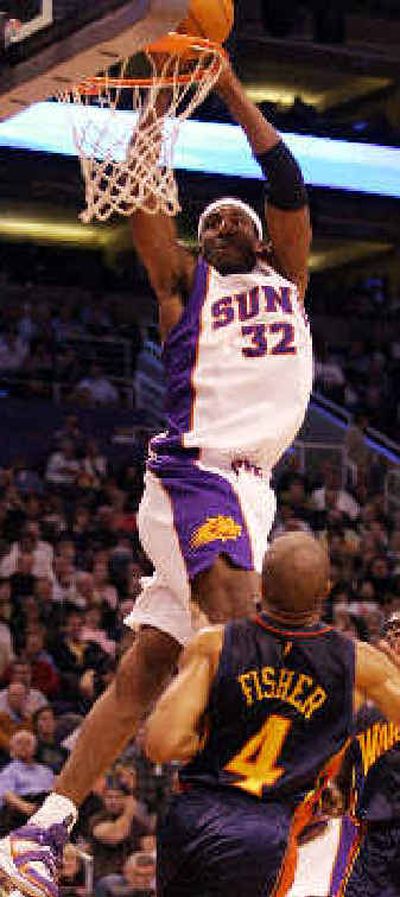Phoenix rises to top of standings with solid mix

PHOENIX – Slam-dunks galore, 3-pointers from everywhere, scores rising like a slot machine jackpot and a mop-haired master of the game directing a full-throttle pace, while most of the rest of the NBA is still stuck in a half-court snooze.
With Steve Nash at the controls, the Phoenix express is blowing a breath of fresh air out of the desert. The youngest team in the NBA is proving that pro basketball can still be fun and fast.
“We’re students of the game,” Amare Stoudemire said, “and right now we’re making straight A’s.”
Going into this weekend, the Suns were 16-3 – 9-1 on the road after a 110-107 victory over the Lakers in Los Angeles on Wednesday night.
Stoudemire, the 22-year-old wunderkind still developing his awesome game, is third in the league in scoring at 25.8 points per game. Shawn Marion, having his finest season, is out of position at power forward but is third in rebounding at 12.1 per contest and is averaging 19.7 points per game.
At point guard, Nash is in a class by himself, far in front of his NBA counterparts at 10.9 assists per game, along with 16.6 points on 55-percent shooting.
On the wings, Joe Johnson (15.7 points) and Quintin Richardson (13.9) can light up any arena on any given night.
“I imagine it has to be fun to watch,” Richardson said. “We have a great deal of fun playing that way. It’s the best kind of basketball I’ve been playing since playground ball. Even in high school and college, you didn’t play this brand, where you just get it and go.”
The team averages 108.6 points per game, almost six points more than the Washington Wizards, the NBA’s second-highest scorers.
“I guess it’s a throwback. When I was growing up, this is how everyone played,” Nash said. “Times have changed, but you’ve got to play to your strength. There’s a big reason teams don’t play that style, because they can’t. This is the way I’ve always played the game. I think it’s a lot more fun than walking up the court.”
The coach is low-key, self-effacing Mike D’Antoni, a star point guard for 13 seasons in Italy who knows his team is at its best when it’s not running any set plays.
“That’s how it should be,” he said. “I don’t even want to know what we’re doing. I just want our players to know how to play basketball and be unselfish with a lot of energy. We don’t want anybody to be able to scout us. We didn’t run many plays the other night and we scored 121 points. That’s ideal.”
Foes often hardly know what hit them.
After a ho-hum three quarters, the Suns buried Golden State with a 21-0 fourth-quarter blitz. Down by 13 at the Staples Center in the fourth, a 15-0 outburst caught the Los Angeles Lakers, then Richardson’s 3-pointer won the game.
None of this, of course, would have happened without Nash.
The Suns, who went 29-53 last season, sent a massive entourage to Dallas to lure the free agent playmaker from the Mavericks to the team that drafted him out of Santa Clara eight years before.
It worked. Nash signed a six-year, $66 million contract, widely viewed as overpayment at the time. So far, he seems worth every penny.
After the deal was signed, Nash agreed to restructure it so the team could sign Richardson. That move triggered rumors that Marion or Johnson would be traded. Those might be the best deals the Suns never made.
Even going into the season opener, though, D’Antoni was uncertain whether he could get away with the small lineup that has Stoudemire at center, with Marion at the so-called power forward spot. Richardson switches from his normal guard spot to small forward, with Johnson the shooting guard, or maybe the other way around. With the Suns it doesn’t really matter.
D’Antoni went with it in the opener, then kept it on a 3-1 road trip, and he’s not about to change.
Stoudemire was lukewarm about playing center full time, but the results have changed his mind.
“It seems to be working out,” he said. “I can pretty much contain centers if we come with an aggressive double-team, and they can’t contain me. That opens up the game of basketball for the whole team.”
Nash’s options are as athletically gifted as they come. Outnumbered defenders must cringe when Nash is coming at them with Stoudemire and Marion on the wings.
“The thing about Steve is he’s probably one of the fastest guys with the ball,” Stoudemire said, “and me and Shawn are probably the fastest guys without the ball. With that combination, it’s an amazing thing.”
Stoudemire joined Marion on this year’s U.S. Olympic team, but saw little playing time under coach Larry Brown. Stoudemire used the opportunity, though, to expand his game. Quick and powerful, he won the NBA rookie of the year award two seasons ago by more or less bulling his way to the hoop. Now he has a softer shooting touch inside and can hit mid-range jumpers. Most impressive, he’s developed the skill to pass out of the double-team to any of the array of sharpshooters at his disposal.
“Amare’s just scratching the surface,” Nash said. “He’s just trying to figure out who he is as a player and a person. He has an incredible amount of growth to go, and it’s exciting to see him do it.”
Off the bench, Casey Jacobsen gives the team another shooter and solid defender. Jake Voskuhl and Steven Hunter give the team some size when the matchups are too overwhelming for the starters. Leandro Barbosa, who started at point guard after Stephon Marbury was traded last season, gives Nash a few much-needed breathers.